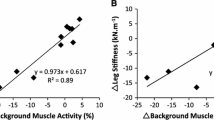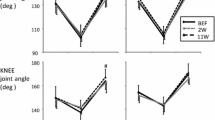Abstract
The aim of this study was to characterize the influence of intrinsic musculotendinous and musculoarticular stiffness of plantarflexor muscles on (1) the overall musculoskeletal stiffness and (2) the performance during stretch-shortening cycles-type exercise. The influence of plyometric training background on these relationships was also analyzed. Musculotendinous (SIMT), passive (K P ) and active (SIMA) musculoarticular stiffnesses were quantified, using quick-release and sinusoidal perturbation tests, on nine French elite long or triple jumpers (athlete group, AG) and nine control subjects (CG). These ergometric parameters were related with the lower-limb stiffness (K leg) and the maximal performance (H max) measured from a force platform during vertical hopping. AG showed a significantly higher SIMT (2.76 rad−1), K P (55.6 N m rad−1), K leg (30.3 kN m−1) and H max (0.48 m) compared to CG (1.83 rad−1, 37.8 N m rad−1, 19.6 kN m−1 and 0.38 m, respectively). K leg was not significantly correlated with any of the intrinsic stiffness parameters (SIMT, SIMA or K P ). For AG, a strong and negative correlation was observed between H max and K leg. These data indicate that, while elite jumpers presented higher stiffness of both musculotendinous and passive musculoarticular structures, a high compliance of musculoskeletal system was beneficial to optimize the performance in vertical hopping for these athletes. We suggested that neuromuscular strategies were designed to counterbalance this higher intrinsic stiffness to solve the problem of the conflicting requirement of the musculotendinous elements: increase in compliance to enhance the elastic recoil and increase in stiffness for a better force transmission to the periphery.



Similar content being viewed by others
References
Almeida-Silveira MI, Perot C, Pousson M, Goubel F (1994) Effects of stretch-shortening cycle training on mechanical properties and fibre type transition in the rat soleus muscle. Pflugers Arch 427:289–294
Anderson FC, Pandy MG (1993) Storage and utilization of elastic strain energy during jumping. J Biomech 26:1413–1427
Arampatzis A, Schade F, Walsh M, Brüggemann G (2001) Influence of leg stiffness and its effect on myodynamic jumping performance. J Electromyogr Kinesiol 11:355–364
Arampatzis A, Karamanidis K, Stafilidis S, Morey-Klapsing G, Demonte G, Bruggemann GP (2006) Effect of different ankle- and knee-joint positions on gastrocnemius medialis fascicle length and EMG activity during isometric plantar flexion. J Biomech 39:1891–1902
Bobbert MF (2001) Dependence of human squat jump performance on the series elastic compliance of the triceps surae: a simulation study. J Exp Biol 204:533–542
Bojsen-Moller J, Magnusson SP, Rasmussen LR, Kjaer M, Aagaard P (2005) Muscle performance during maximal isometric and dynamic contractions is influenced by the stiffness of the tendinous structures. J Appl Physiol 99:986–994
Blickhan R (1989) The spring mass model for running and hopping. J Biomech 22:1217–1227
Burgess KE, Connick MJ, Graham-Smith P, Pearson SJ (2007) Plyometric vs. isometric training influences on tendon properties and muscle output. J Strength Cond Res 21:986–989
Cavagna GA (1977) Storage and utilization of elastic energy in skeletal muscle. Exerc Sport Sci Rev 5:89–129
Cavagna GA, Citterio G, Jacini P (1981) Effects of speed and extend of stretching on the elastic properties of active frog muscle. J Exp Biol 91:131–143
Cornu C, Almeida Silveira MI, Goubel F (1997) Influence of plyometric training on the mechanical impedance of the human ankle joint. Eur J Appl Physiol 76:282–288
Farley CT, Morgenroth DC (1999) Leg stiffness primarily depends on ankle stiffness during human hopping. J Biomech 32:267–273
Farley CT, Blickhan R, Saito J, Taylor CR (1991) Hopping frequency in humans: a test of how springs set stride frequency in bouncing gaits. J Appl Physiol 71:2127–2132
Goubel F, Marini JF (1987) Fibre type transition and stiffness modification of soleus muscle of trained rats. Pflugers Arch 410:321–325
Goubel F, Pertuzon E (1973) Evaluation of the elasticity of muscle in situ by the quick-release method. Arch Int Physiol Biochim 81:697–707
Hill AV (1938) The heat of shortening and the dynamic constant of muscle. Proc R Soc Lond B Biol Sci 126:136–195
Hof AL (1998) In vivo measurement of the series elasticity release curve of human triceps surae muscle. J Biomech 31:793–800
Hof AL, Van Zandwijk JP, Bobbert MF (2002) Mechanics of human triceps surae muscle in walking, running and jumping. Acta Physiol Scand 174:17–30
Hunter IW, Kearney RE (1982) Dynamics of human ankle stiffness: variation with mean ankle torque. J Biomech 15:747–752
Huxley AF, Simmons RM (1971) Mechanical properties of the cross-bridges of frog striated muscle. J Physiol 218:59–60
Jaric S (2003) Role of body size in the relation between muscle strength and movement performance. Exerc Sport Sci Rev 31:8–12
Kearney RE, Hunter IW (1990) System identification of human joint dynamics. Crit Rev Biomed Eng 18:55–87
Komi PV (2000) Stretch-shortening cycle: a powerful model to study normal and fatigued muscle. J Biomech 33:1197–1206
Kubo K, Kawakami Y, Fukunaga T (1999) Influence of elastic properties of tendon structures on jump performance in humans. J Appl Physiol 87:2090–2096
Kubo K, Kanehisa H, Kawakami Y, Fukunaga T (2000a) Elastic properties of muscle-tendon complex in long-distance runners. Eur J Appl Physiol 81:181–187
Kubo K, Kanehisa H, Kawakami Y, Fukunaga T (2000b) Elasticity of tendon structures of the lower limbs in sprinters. Acta Physiol Scand 168:327–335
Kubo K, Morimoto M, Komuro T, Tsunoda N, Kanehisa H, Fukunaga T (2007) Influences of tendon stiffness, joint stiffness, and electromyographic activity on jump performances unsing single joint. Eur J Appl Physiol 99:235–243
Kyröläinen H, Finni T, Avela J, Komi PV (2003) Neuromuscular behavior of the triceps surae muscle-tendon complex during running and jumping. Int J Sports Med 24:153–155
Laffaye G, Bardy BG, Durey A (2005) Leg stiffness and expertise in men jumping. Med Sci Sports Exerc 37:536–543
Lambertz D, Perot C, Kaspranski R, Goubel F (2001) Effects of long-term spaceflight on mechanical properties of muscles in humans. J Appl Physiol 90:179–188
Levy EC (1959) Complex curve fitting. IEEE Trans Automat Contr 4:34–43
McLachlan KA, Murphy AJ, Watsford ML, Rees S (2006) The interday reliability of leg and ankle musculotendinous stiffness measures. J Appl Biomech 22:296–304
McMahon TA, Cheng GC (1990) The mechanics of running: how does stifness couple with speed? J Biomech 23(Suppl 1):65–78
Ochala J, Lambertz D, Pousson M, Goubel F, Van Hoecke J (2004) Changes in mechanical properties of human plantar flexor muscles in ageing. Exp Gerontol 39:349–358
Perttunen JO, Kyröläinen H, Komi PV, Heinonen A (2000) Biomechanical loading in the triple jump. J Sports Sci 18:363–370
Pousson M, Van Hoecke J, Goubel F (1990) Changes in elastic characteristics of human muscle induced by eccentric exercise. J Biomech 23:343–348
Pousson M, Perot C, Goubel F (1991) Stiffness changes and fibre type transitions in rat soleus muscle produced by jumping training. Pflugers Arch 419:127–130
Pousson M, Legrand J, Bergaud S, Van Hoecke J (1995) Détente et élasticité : effets d’un entraînement pliométrique. Sci Motricité 25:19–26
Ross A, Leveritt M (2001) Long-term metabolic and skeletal muscle adaptations to short-sprint training: implications for sprint training and tapering. Rev Sports Med 31:1063–1082
Seyfarth A, Friedrichs A, Want V, Blickan R (1999) Dynamics of the long jump. J Biomech 32:1259–1267
Shorten MR (1987) Muscle elasticity and human performance. Med Sport Sci 25:1–18
Spurrs RW, Murphy AJ, Watsford ML (2003) The effect of plyometric training on distance running performance. Eur J Appl Physiol 89:1–7
Toft E, Sinkjaer T, Larsen K, Andreassen S (1991) Mechanical and electromyographical responses to stretch of human ankle extensors. J Neurophysiol 65:1402–1410
Tognella F, Mainar A, Vanhoutte C, Goubel F (1997) A mechanical device for studying mechanical properties of human muscles in vivo. J Biomech 30:1077–1080
Voigt M, Simonsen EB, Dyhre-Poulsen P, Klausen K (1995) Mechanical and muscular factors influencing the performance in maximal vertical jumping after different prestretch loads. J Biomech 28:293–307
Viitasalo JT, Salo A, Lahtinen J (1998) Neuromuscular functioning of athletes and non-athletes in the drop jump. Eur J Appl Physiol 78:432–440
Walshe AD, Wilson GJ (1997) The influence of musculotendinous stiffness on drop jump performance. Can J Appl Physiol 22:117–132
Acknowledgments
This study was part of a major work supported by the French Minister of Health, Sports and Associative Life. We thank Professor Francis Goubel and Professor Chantal Pérot for their implication in the collaboration between the Technological University of Compiègne (UTC) and the French National Institute of Sports (INSEP).
Author information
Authors and Affiliations
Corresponding author
Rights and permissions
About this article
Cite this article
Rabita, G., Couturier, A. & Lambertz, D. Influence of training background on the relationships between plantarflexor intrinsic stiffness and overall musculoskeletal stiffness during hopping. Eur J Appl Physiol 103, 163–171 (2008). https://doi.org/10.1007/s00421-008-0679-9
Accepted:
Published:
Issue Date:
DOI: https://doi.org/10.1007/s00421-008-0679-9




